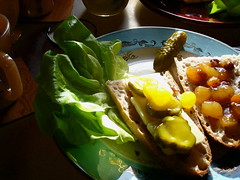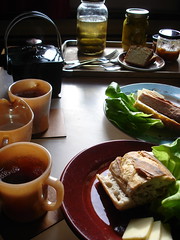Ploughman's Lunch, rev. ed.

Last year, our Chutneys Division found itself focusing on more or less traditional varieties, chutneys that hailed from the Indies, both East and West, and were tropical in character, with Devil Chutney being a particularly popular manifestation of that particular campaign. This year we've been concentrating on varieties that are very much products of Indo-British contact and the diaspora that resulted, ones based largely on non-tropical fruit. Contrary to the beliefs of many, chutney—or chutni, or chatni [compare with chat or chaat]—is a class of relishes that predates Indo-British contact by a long shot. There's no question that the British developed are particular liking for chutney, and appear to have encouraged the development of chutneys that were sweeter, rather than sour or sweet and sour as they had been, perhaps in an attempt to counter the fieriness of the cuisine they encountered there in the Indian subcontinent, especially in certain southern regions and on the island then known as Ceylon. But chutneys made with spices, herbs, and a base of tamarind, lime, garlic, or coconut, among others, had long been used to add counterpoint to Indian cuisine. In fact, in some parts of India, notably Kashmir, there were already chutneys that anticipated those that one might think were the most Western, including varieties involving walnuts, squashes, and stone fruits.
With all of this in mind, this year's experiments have been decidedly Western. As our sign for this year's batch of plum chutney read at Puces Pop, "So what if there ain't no plums in India? Ain't no law again't it." We’d already been very happy with the chutneys that had resulted from this year’s campaign, but last week we went and hit the mother lode. I’d gotten it in my head that I wanted to try making a pear chutney. We researched some recipes, ran some tests, made some adjustments, and lo and behold somehow we managed to make the very best chutney either of us had ever tasted, our very own Golden Pear Chutney. Sounds like an awfully bold claim, I know, but that combination of pear, confited onion and lemon, candied ginger, and spices was absolutely irresistible, and we instantly started creating any excuse we could to eat it. We just couldn’t get enough of it. After a couple of days, I’d already maxed out on Indian dishes, and we’d had chutney with cheese and crackers (in that order) on several occasions. It was then that I came up with yet another bright idea, one which would take full advantage of a number of this year’s stock of preserves, including that truly awesome Golden Pear Chutney: I decided it was time we created “…an endless banquet’s” take on that most contested of British (modern) classics, the Ploughman’s Lunch.
First, you’re going to need to make your very own batch of…
Golden Pear Chutney
1 pound peeled (make sure to reserve the pear peels), cored, unwaxed, just-ripe pears (preferably Flemish beauties), cut into 1/2 inch pieces + 1 pear
1 cup light brown sugar
2/3 cup onion, chopped into 1/4 inch pieces
1/2 small lemon, peeled and thinly sliced
1 teaspoon mustard seeds
1/2 tsp cayenne pepper
1/2 scant tsp cinnamon
1 pinch nutmeg
1 pinch ground cloves
1 pinch ground ginger
1/4 generous tsp ground white pepper
1/4 cup chopped crystallized ginger
1/3 cup dark raisins
1/3 cup light raisins
1 cup apple cider vinegar
1 shot pear eau-de-vie
In a three-quart non-reactive saucepan, simmer the extra pear and the pear peels in about 2 cups water for 10-15 minutes. Strain over a bowl, return the cooking liquid to the saucepan, add the onions, the spices, the brown sugar, and the lemon, and boil until you have a thickened syrup and the onions and lemon have been confited, 20 to 30 minutes.
Meanwhile, mix the vinegar, the raisins, and the candied ginger with the pears and let them macerate.
When the syrup is ready, add the pear mixture and the eau-de-vie to it and simmer until the mixture has thickened up a bit, like a proper chutney, the raisins and pears have softened, and the vinegar has mellowed, about 15-30 minutes.
[Adapted from a recipe in John Martin Taylor’s Lowcountry Cooking]
Once you’ve got a batch of Golden Pear Chutney, you’re well on your way to making your own “…an endless banquet”-style Ploughman’s Lunches.

This was our spread:
• 1 premium, extra-sharp cheddar (we used Perron 4-year aged cheddar because it’s just about the best cheddar we can get locally—of course, if we’d been able to get something like the Montgomery cheddar we’d had the week before down in the States, we would have)
• 1 good, crusty loaf of bread (we used Première Moisson’s Pain de campagne, but, in retrospect, a loaf from Fromentier would probably have been an even better fit)
• 1 head of Boston lettuce
• 1 jar Golden Pear Chutney (you can see it there on the right in the picture up at the very top)
• 1 jar oignons confits
• 1 jar mustard pickles
• 1 jar dill pickles
• 1 pot properly steeped tea
• 1 serving pound cake, for dessert
If you don’t have any oignons confits, you might want to seek out something like Branston pickle instead. If you don’t have any homemade mustard pickles or commercial picalilli, you might want to get yourself some pickled onions. And there are plenty of other ways in which you could improvise. Frankly, if you start off with a chutney as ridiculously good as this Golden Pear Chutney, it’s hard to go wrong. We could have used a couple of pints of hand-pulled ale and maybe even some quality crisps to accompany our Ploughman’s Lunches, but otherwise, with bright sunshine pouring through the window into our living room, it made for the perfect weekend luncheon.
aj









8 comments:
Candied ginger, huh? I'm intrigued. I wish I wasn't. Why do you guys have to be so damn great? Now I'm going to be stopping at the market on the way to band practice and staying up til 3am simmering chutney afterwards. My new roommate's gonna think I'm really weird.
Sounds great! Do you have any suggestions for canning? Do you think the easy "put the lid on the hot jam" method would be okay?
CWI,
Be intrigued. Be very intrigued. Your roomie gives you grief, you let us know...
Hi anonymous,
It is great. We do most of our canning using the dry method, and, yes, the chutney should be hot when it goes in the jar. Have fun.
Wow! I got a little scared from that huge list of ingredients, but it turns out I already have most of them (they're stuff I want to get rid of, too...)! I'm definitely going to try it out!
Also, I was looking for info on Poilane's bread, and found one of your old posts... Did you know that Cafe Holt (@ Holt Renfrew) imports them? You can get their croque-monsieurs with Poilane bread (15$+ for a slice thinner than your small finger, some mayo and some meat...), or a quarter miche for 10$ (~15 slices)... and make an even better Ploughman's Lunch! :9
Very sexy food blog, indeed. You are already on my blogroll at Enjoy - Food and Travel. Impressive track record as well, having stories so far back in time.
Good luck! And I'm in very often to get updated
Tor Johnsen
Hi chokorate,
I hope the chutney works out for you.
As for Poilâne bread: we know all about Holt Renfrew's importation of Poilâne bread. In fact, we posted about it almost a year ago here: http://endlessbanquet.blogspot.com/2005/12/great-whatsit.html
You've got to wake up pretty early in the morning to pull one over on "...an endless banquet."
I'm sure it would make a great Ploughman's Lunch, but those Poilâne loaves just aren't the same outside of Paris. They're also a helluva lot more expensive. For all those who've never tried Poilâne bread, however, and those who don't foresee going to Paris anytime in the near future, well...
Thanks for reading and commenting and good luck with the chutney.
dear Tor Johnsen,
Wow, "sexy." That's the first time that adjective has ever been used to describe "...an endless banquet," I'm sure. Well, it's about time, really.
Thanks for reading and commenting and keep up the good work on Enjoy - Food and Travel.
Hi Anthony,
I'm planning to cook the chutney by the end of the week - mmm pears and candied ginger, I just cant' resist any more - and I'd like to know: how much does it yield (approx)?
Thanks!
Anne-Hélène
Hi Anne-Hélène,
I'm glad you're going to give it a shot. Everyone I've talked to who's tried it has had success with the recipe. Try and find some good quality crystallized ginger. You'll be happy you did. One of the reasons this recipe is so good, though, has to do with an ingredient that few have remarked upon: the lemon. Candying the lemon with the spices, et al., gives the chutney a lovely flavor and add yet another dimension to its texture.
Anyway, I've been making larger quantities for the last little while, so I can't say for sure, but my guess would be about 6 250-ml jars. Remember that the recipe (somewhat unconventionally) calls for you to measure the weight of the pears after they've been peeled and cored.
Lastly, try and get the best pears you can get your hands on/afford. We've been using Flemish Beauties, which are one of our favorites, but they're time is just about up.
Good luck!
Post a Comment